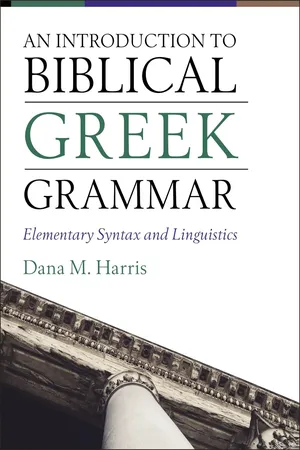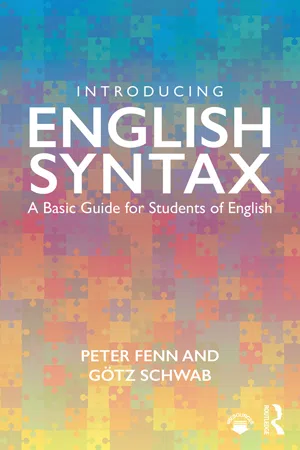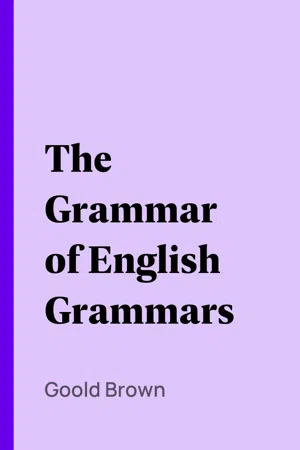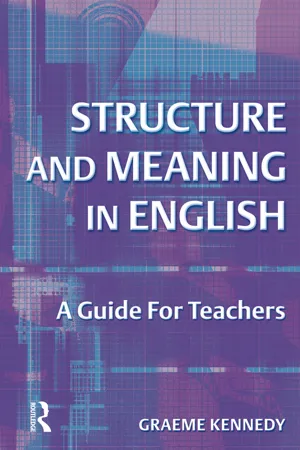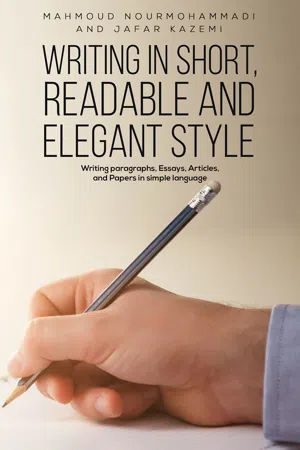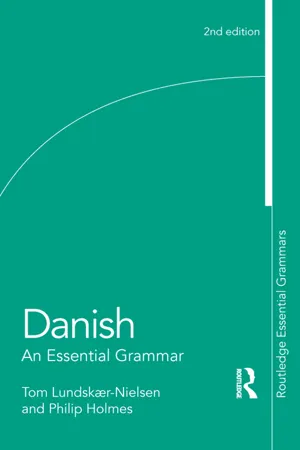Languages & Linguistics
Participial Phrase
A participial phrase is a group of words consisting of a participle (a verb form used as an adjective) and any accompanying modifiers or complements. It functions as an adjective, modifying a noun or pronoun in a sentence. Participial phrases can add descriptive detail and provide additional information about the subject of a sentence.
Written by Perlego with AI-assistance
Related key terms
Related key terms
1 of 4
Related key terms
1 of 3
8 Key excerpts on "Participial Phrase"
- eBook - ePub
An Introduction to Biblical Greek Grammar
Elementary Syntax and Linguistics
- Dana M. Harris(Author)
- 2020(Publication Date)
- Zondervan Academic(Publisher)
chapter THIRTEEN THE PRESENT PARTICIPLE AND PARTICIPLE BASICS
Chapter 13 introduces the following linguistic concepts, morphemes, and paradigms: • participle morphemes • present participle paradigms • basic participle functions: substantival, attributive, adverbial • lexical form for present participles and parsing • the adjective πᾶςOBJECTIVES AND OVERVIEWTHE PRESENT PARTICIPLE AND BASIC PARTICIPLE FUNCTIONSA participle is a verbal adjective . This means that it has one foot in the verb world and the other foot in the adjective world. As a verbal adjective, it shares characteristics with verbs, such as voice and tense stems (which indicate aspect).1 Verbal characteristics are also reflected in the fact that a participle can have a direct or indirect object and adverbial modifiers, such as adverbs or adverbial prepositional phrases. As a nonfinite verb, participles do not have person (first, second, or third). Additionally, a participle is usually negated with the particle μή. As a verbal adjective , it shares characteristics of adjectives, such as case, number, and gender. For this reason, participles use first, second, or third declension case endings.Participles function either adverbially or adjectivally. When a participle functions adverbially, it modifies a verb and is dependent on that verb (e.g., “entering Capernaum, Jesus preached the gospel”). A participle can never be a main (or independent) verb, because it does not have person and number (hence it is not a finite verb). When a participlefunctions adjectivally, it either modifies a substantive or functions as a substantive, which parallels how adjectives function (e.g., “the living water” or “the believing [one]”).Participles are constructed from tense stems. The aspect of participles is indicated by the tense stem from which it is constructed, although aspect is less prominent in participles than it is with finite verbs. In this chapter we will learn present participles, which are constructed using the present tense stem (the first principal part) and have imperfective aspect. In later chapters, we’ll learn aorist and perfect participles. (There are a handful of future participles that we’ll also discuss later.) The imperfect and pluperfect tense stems only occur in the indicative mood, so there are no imperfect or pluperfect participles. - eBook - ePub
Introducing English Syntax
A Basic Guide for Students of English
- Peter Fenn, Götz Schwab(Authors)
- 2017(Publication Date)
- Routledge(Publisher)
The faces were smiling .Participles used in this part-verb and part-adjective role just described can best be regarded as ‘verbal adjectives’. However, some of these, mainly with abstract meanings, have lost their verbal character completely over time, and have developed lexically into full adjectives. Examples like boring , comforting , interesting , worrying , etc., behave grammatically as normal adjectives: they can be compared (more /less worrying ) and occur predicatively: The story seemed interesting at first, but turned out rather boring .9.1.6 Distinguishing the present participle from the gerundAs was said at the beginning of the chapter, it is analytically important to make a clear distinction between the present participle and the gerund. As they share the same form and both function as predicators in their own sub-clauses, they can easily be confused. In clausal terms, however, they have very different functions and meanings, as we have shown, and should therefore be kept apart conceptually. Below, in table form, is a summary of the contrasts.p.201 As we will see later, there are also clear distinctions at phrase level. 9.2 The past participle and its clauseIn function, past participle clauses are similar to present participle clauses, i.e. they are mainly adverbial. As clauses, they also have an accompanying (or parallel) meaning, and the same kind of subject relation:However, there is an important contrast between the individual semantics of the two participles themselves:• the present participle is active (in terms of voice), and imperfective (in terms of aspect); • the past participle is generally passive (in terms of voice), and always perfective (in terms of aspect).The past participle, in other words, expresses a state (and not an action) as an ‘accompanier’ to the reference in the main clause. The state, however, results - eBook - ePub
- Goold Brown(Author)
- 2004(Publication Date)
- Perlego(Publisher)
participial adjective is one that has the form of a participle, but differs from it by rejecting the idea of time; as, "An amusing story,"—"A lying divination."VI. A compound adjective is one that consists of two or more words joined together, either by the hyphen or solidly: as, Nut-brown, laughter-loving, four-footed; threefold, lordlike, lovesick.OBSERVATIONS.
OBS. 1.—This distribution of the adjectives is no less easy to be applied, than necessary to a proper explanation in parsing. How many adjectives there are in the language, it is difficult to say; none of our dictionaries profess to exhibit all that are embraced in some of the foregoing classes. Of the Common Adjectives, there are probably not fewer than six thousand, exclusive of the common nouns which we refer to this class when they are used adjectively. Walker's Rhyming Dictionary contains five thousand or more, the greater part of which may be readily distinguished by their peculiar endings. Of those which end in ous, as generous, there are about 850. Of those in y or ly, as shaggy, homely, there are about 550. Of those in ive, as deceptive, there are about 400. Of those in al, as autumnal, there are about 550. Of those in ical, as mechanical, there are about 350. Of those in able, as valuable, there are about 600. Of those in ible, as credible, there are about 200. Of those in ent, as different, there are about 300. Of those in ant, as abundant, there are about 170. Of those in less, as ceaseless, there are about 220. Of those in ful, as useful, there are about 130. Of those in ory, as explanatory, there are about 200. Of those in ish, as childish, there are about 100. Of those in ine, as masculine, there are about 70. Of those in en, as wooden, there are about 50. Of those in some, as quarrelsome, there are about 30. These sixteen numbers added together, make 4770.OBS. 2.—The Proper Adjectives are, in many instances, capable of being converted into declinable nouns: as, European, a European, the Europeans; Greek, a Greek, the Greeks; Asiatic, an Asiatic, the Asiatics - eBook - ePub
Structure and Meaning in English
A Guide for Teachers
- Graeme Kennedy(Author)
- 2014(Publication Date)
- Routledge(Publisher)
participial adjective which parallels the adjective fervent and can be preceded by very. Opposing has the form of an -ing participle. It is used here as a participial adjective which modifies ‘groups’. Participial adjectives are used frequently, especially in academic and journalistic written genres. Learners of English often find participial adjectives confusing and sometimes interpret them as verbs. Compare these sentences:In Sentences 1–3, the words in bold type are participial adjectives. In Sentences 4–6, the words in bold type are participles in complex verb phrases.1 This rule is amazing.2 I was relieved. (= stopped worrying)3 Grammar is interesting.4 Sue is amazing her doctors.5 I was relieved by another teacher. (= replaced)6 This problem is interesting all of us.The confusion between some adjectives and verbs is not surprising because in some languages there is no difference. For example, while English has The red cloth or The cloth is red, some other languages can say the equivalent of The cloth reds, i.e. what is an adjective in English can be a verb in some other languages. This relationship between verbs and adjectives is also sometimes seen in English. Compare:Her head is sore.Her sore head.Her head is aching.Her aching head.Some grammarians have suggested that English attributive adjectives can be derived from predicative adjectives or participles by means of reduced relative clauses, e.g.1 The animal [The animal was captured by the trap] was frightened.2 ⇒ The animal which was captured by the trap was frightened.3 ⇒ The animal captured by the trap was frightened.4 ⇒ The animal captured was frightened.5 ⇒ The captured animal was frightened.Note also that frightened - eBook - ePub
- Ruth Laila Schmidt(Author)
- 2005(Publication Date)
- Routledge(Publisher)
9
PARTICIPLES AS QUALIFIERS
Imperfective and perfective participles may be used adjectivally and adverbially. Matching forms of the perfective participle of are often added to make Participial Phrases. For the forms of the imperfective participle, see §603; for the perfective participle, see §604. When participles are used as qualifiers, they are inflected like adjectives, and the feminine plural forms are not used.Conjunctive participles (§612) may be used adverbially (§913).IMPERFECTIVE PARTICIPLES
The imperfective participle describes actions or states which are incomplete (and often continuing) at the time shown by the main verb.901 Adjectival use of imperfective participles
An imperfective participle may modify a noun like an adjective. Adjectival participles agree with the noun in number and gender, and usually occur in phrases with . Preceding a noun, adjectival participles are used attributively (§306).The shivering woman began to cry.Give another push to the falling walls.You should not have tried to get on the moving bus.Following a noun, adjectival participles are used predicatively (§306).902 Adverbial use of imperfective participles
An imperfective participle (usually in phrases with may add a context to the main verb, or show the simultaneity of the two actions, like an adverb. Adverbial participles are masculine oblique singular.Zakir was singing a song as he bathed.Zakir was singing a song as he walked.An adverbial participle may precede the subject, if it is given more prominence than the main verb.While fleeing - eBook - ePub
- David Kilby(Author)
- 2019(Publication Date)
- Routledge(Publisher)
Chapter Five Passive ParticiplesIn a sentence such as (1), is the participle hurt to be considered an adjective or a verb? And whichever way this question is answered, does the same hold true for all other passive participles?- 1. John was hurt by her response
These are innocent-sounding questions: indeed, it would not be difficult to dismiss them as being somewhat scholastic. There is currently considerable debate on this topic within transformational grammar (or rather, post-transformational grammar), but the questions which are at issue there are rather narrowly theoretical and depend on assumptions which, in spite of being taken for granted in most such research, are scarcely argued for at all. However, a detailed discussion of this issue raises a host of substantive problems as well, and casts some doubt on the whole notion of there being clear distinctions between grammatical categories.The criteria by which we can distinguish adjectives from verbs fall into two types: firstly we can distinguish lexical categories by the range of contexts in which they occur - e.g. verbs are the only elements which can form a predicate (VP) on their own in English. But criteria of this sort do not help us with passive participles: we know that they are related to verbs - what we want to know is whether they are simply one form which verbs can take, or whether they are separate words related to verbs by processes of derivation. Fortunately the second set of criteria can be used to make such a distinction; if passive participles are adjectives, we should expect them to have the features in (2), while if they are verbs we expect them to lack those features, but possibly to have the features in (3):2. a. Adjectives have comparative and superlative formsb. Adjectives can be modified byvery ,rather , etc.c. Adjectives occur both after a form of be and before a noun within the noun phrased. Adjectives occur as the complement of verbs such as prove, seem, become, feele. Adjectives often have a negative form in un - eBook - ePub
- Mahmoud Nourmohammadi(Author)
- 2022(Publication Date)
- Austin Macauley Publishers(Publisher)
Chapter 7 Participles
Participles (1): (-ing and -ed Forms)
Introduction
When -ing forms are used in certain ways, for example as parts of verb forms, or like adjectives they are called ‘present participles’. Forms like broken, gone, opened, started are called ‘past participles’. These are not very suitable names: both forms can be used to talk about the past, present or future.She was crying when I saw her.Who’s the man talking to Elizabeth? (= Who’s the man who is talking to Elizabeth?)This time tomorrow I’ll be lying on the beach.It was broken in the storm. The kids are excited.The new school is going to be opened next week.A) Verb Forms
Participles are used with the auxiliary verbs be and have to make progressive, perfect and passive verb forms.It was raining when I got home.I‘ve forgotten your name. You’ ll be told as soon as possible.Present and past participles can be put together to make progressive and perfect forms (e.g., being employed, having arrived, having been invited).B) Adjectives
Participles can be used like adjectives.I love the noise of falling rain.She says she’s got a broken heart.John has become very boring.The house looked abandoned.C) Adverbs
Sometimes participles are used like adverbs.She ran screaming - eBook - ePub
- Tom Lundskaer-Nielsen, Philip Holmes(Authors)
- 2011(Publication Date)
- Routledge(Publisher)
er , two pencils.PART OF SPEECH means word class, e.g. noun, adjective, verb, conjunction, etc.PARTICLE is a stressed adverb or preposition appearing together with a verb to form a phrasal verb with a single unit of meaning, e.g. ned inskrive ned, write down; på inse på, watch; ud inskælde ud, tell off.PARTITIVE denotes a part of a whole or of a substance, e.g.en del af pengene, some of the money;en flaske vin, a bottle of wine;et kilo kartofler, a kilo of potatoes.PEJORATIVE means deprecating, e.g. dit fjols! you idiot!PREDICATE is the central part of the clause, excluding the subject. The predicate comprises the verb plus any object, complement or adverbial:Han spiller (klaver hver dag ), He plays (the piano every day).PREDICATIVE indicates the position after a copula verb:Skuespillet er svært, The play is difficult;De bliver gamle, They’re growing old.PREDICATIVE COMPLEMENT (see COMPLEMENT )PREPOSITIONAL PHRASE consists of a preposition plus a prepositional complement (a noun (phrase), a pronoun, an infinitive (phrase) or a clause), e.g.pigen med det lange hår, the girl with the long hair;pigen tænkte på ham, the girl thought of him;pigen gik uden at sige farvel, the girl left without saying goodbye;pigen sørgede for , at bordet blev dækket, the girl saw to it that the table was set.PRODUCTIVE implies that a word class or method of word formation can still produce new words, e.g. the suffix -bar in vaskbar
Index pages curate the most relevant extracts from our library of academic textbooks. They’ve been created using an in-house natural language model (NLM), each adding context and meaning to key research topics.
Explore more topic indexes
Explore more topic indexes
1 of 6
Explore more topic indexes
1 of 4
